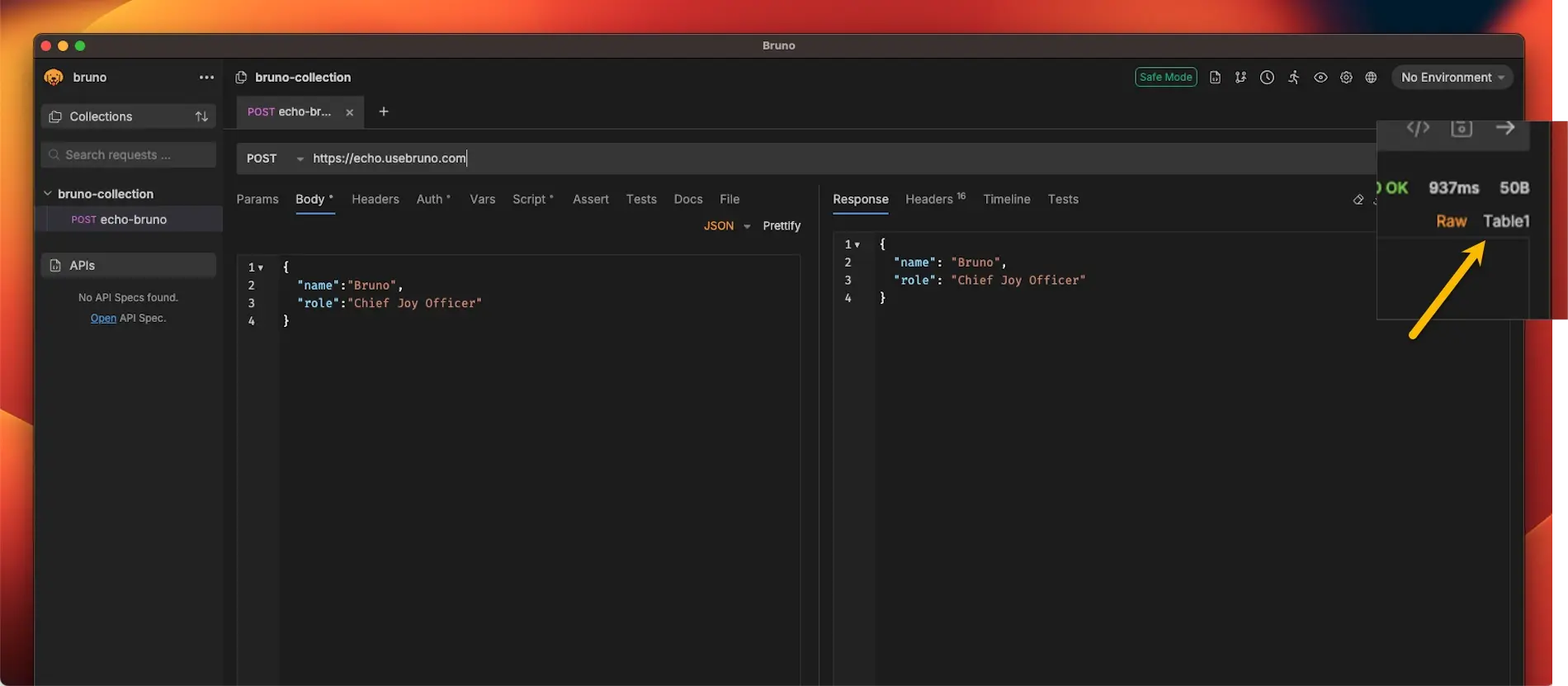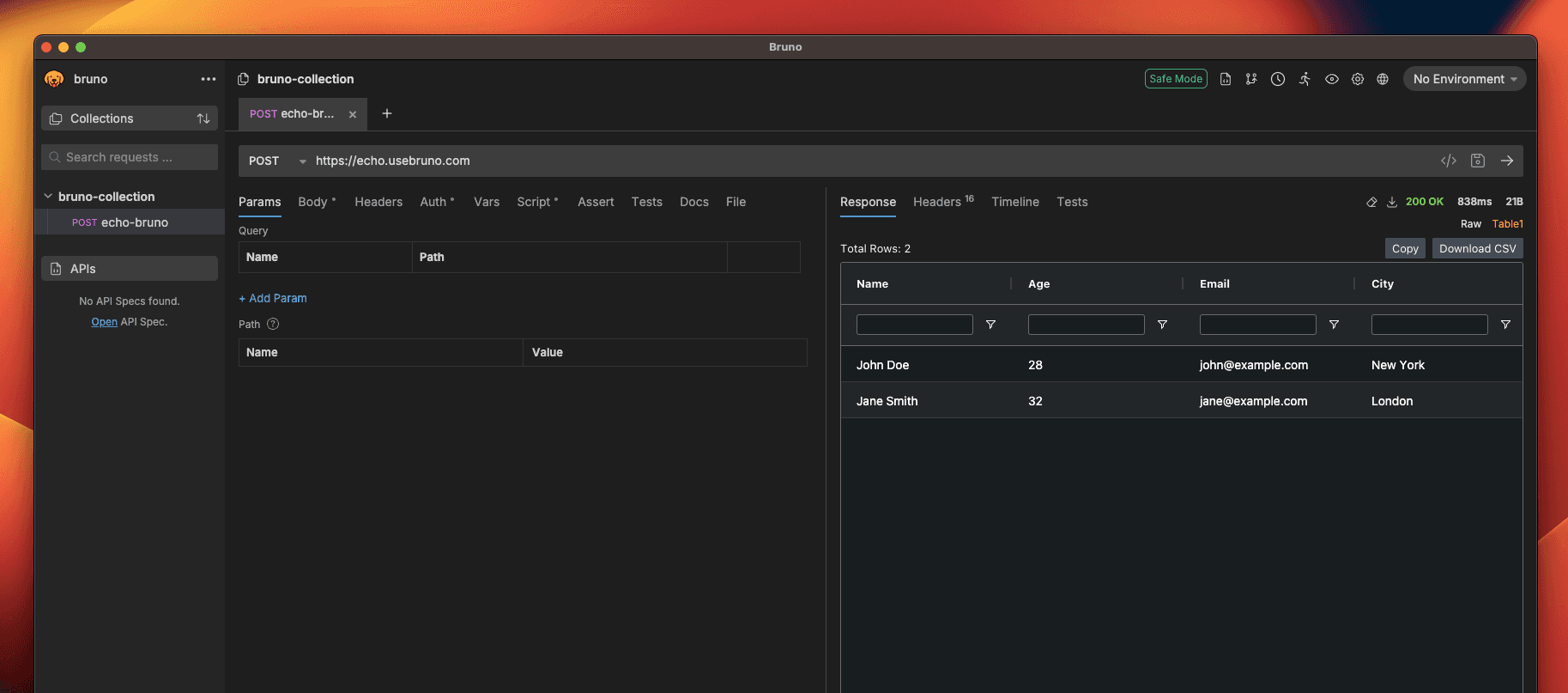Response Visualization
Bruno provides a powerful visualization feature that allows you to display API response data in a more readable and interactive format using the bru.visualize function.
bru.visualize(type, config)-
type: The type of visualization to render (e.g., ‘table’, ‘html’).
-
config: A configuration object that includes:
-
name: The name of the visualization instance.
-
provider: The rendering library or provider used to display the visualization (e.g., ‘ag-grid’, ‘react-table’).
-
props: Additional properties required by the provider to configure the visualization.
-
Supported Visualization Types and Providers
Table Visualization (‘table’)
You can render tables using different providers like ag-grid and react-table.
Using ag-grid
Example:

const rowData = [
{ name: 'John Doe', age: 28, email: 'john@example.com', city: 'New York' },
{ name: 'Jane Smith', age: 32, email: 'jane@example.com', city: 'London' }
];
const columnDefinitions = [
{ field: "name", filter: true, floatingFilter: true },
{ field: "age", filter: true, floatingFilter: true },
{ field: "email", filter: true, floatingFilter: true },
{ field: "city", filter: true, floatingFilter: true }
];
bru.visualize('table', {
name: 'table1',
provider: 'ag-grid',
props: { rowData, columnDefinitions }
});This will render a table using the ag-grid provider with filters enabled on all columns.
Using react-table
Example:

const rowData1 = Array.from({ length: 2500 })
.map((_) => [
{ firstName: 'Tanner', lastName: 'Linsley', age: 24, visits: 100 },
{ firstName: 'Tandy', lastName: 'Miller', age: 40, visits: 40 },
{ firstName: 'Joe', lastName: 'Dirte', age: 45, visits: 20 },
]).flat();
const columnDefinitions1 = [
{
id: "firstName",
cell: (info) => info.getValue(),
header: () => `<span className="flex flex-start">First Name</span>`,
meta: { filterVariant: "text" },
},
{
id: "lastName",
cell: (info) => info.getValue(),
header: () => `<span className="flex flex-start">Last Name</span>`,
meta: { filterVariant: "text" },
},
// Additional column definitions here...
];
bru.visualize('table', {
name: 'table2',
provider: 'react-table',
props: { rowData: rowData1, columnDefinitions: columnDefinitions1 }
});This example renders a large table using the react-table provider, with custom headers and filter variants.
HTML Visualization (‘html’)
You can also render custom HTML content using the html type. This allows for advanced templating and formatting, such as generating a data table or a report.
Using HTML String
Example:

const htmlString = `
<html>
<head>
<style>
table { width: 100%; border-collapse: collapse; }
th, td { border: 1px solid black; padding: 8px; }
th { background-color: #f2f2f2; }
</style>
</head>
<body>
<table>
<tr><th>Name</th><th>Age</th><th>Email</th><th>City</th></tr>
<tr><td>John Doe</td><td>28</td><td>john@example.com</td><td>New York</td></tr>
<tr><td>Jane Smith</td><td>32</td><td>jane@example.com</td><td>London</td></tr>
</table>
</body>
</html>
`;
bru.visualize('html', {
name: 'htmlReport',
content: htmlString
});This example will render an HTML table with predefined data using the html type.
Viewing Your Visualization
- Add the visualization code to your request’s script section
- Execute the request
- Click on the Table option (next to Raw)

- Your visualization will be displayed in the panel

Parameters
| Name | Type | Description |
|---|---|---|
type | string | The type of visualization to render. Supported values: 'table', 'html'. |
config | object | Configuration object for the visualization. See below for available properties. |
Config Properties
| Property | Type | Description |
|---|---|---|
name | string | Name of the visualization instance. |
provider | string | The provider or rendering engine to use for the visualization. E.g., 'ag-grid', 'react-table'. |
props | object | Additional properties required by the provider to configure the visualization. |
content | string | (For html type only) The HTML content to render. |